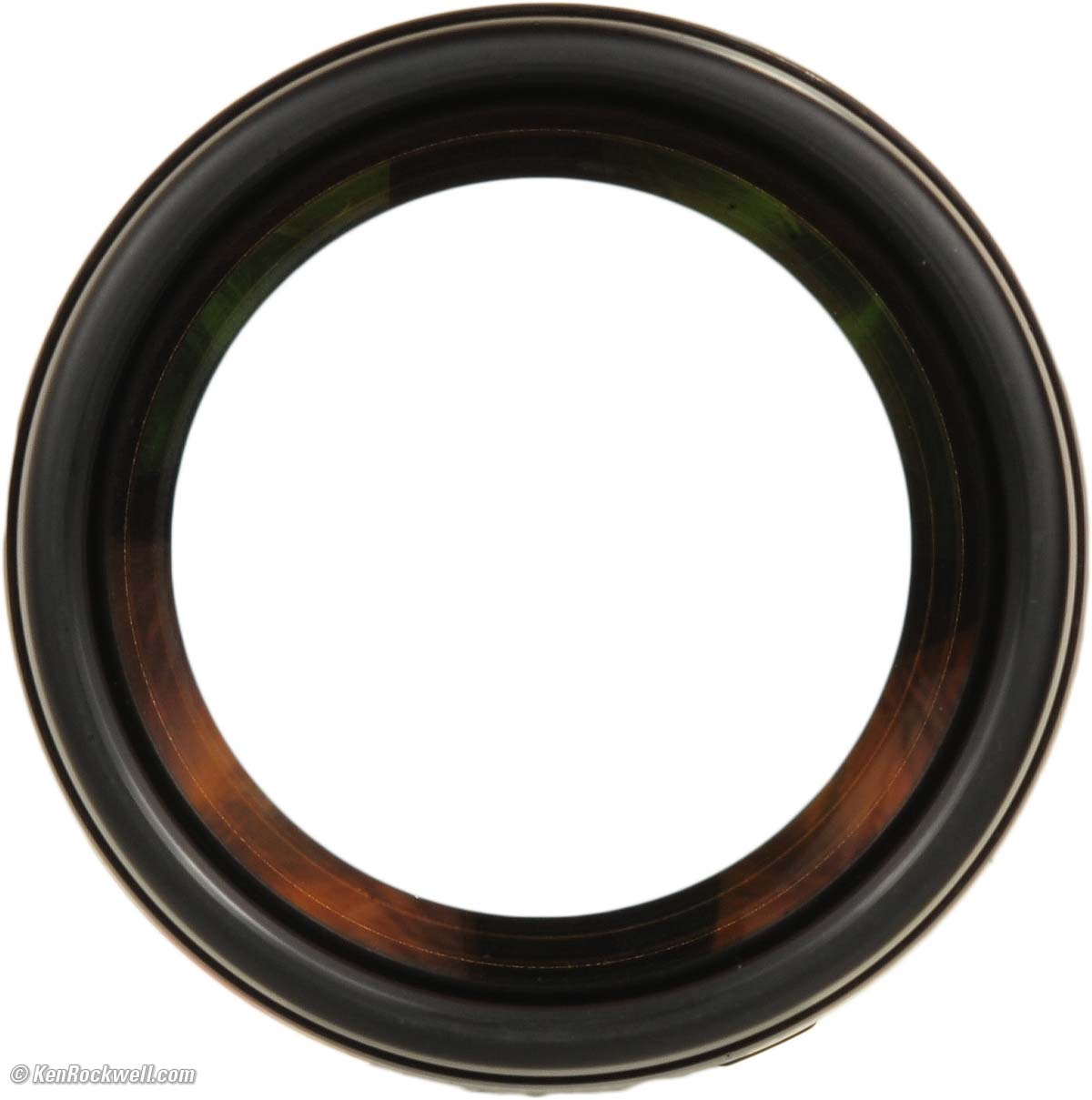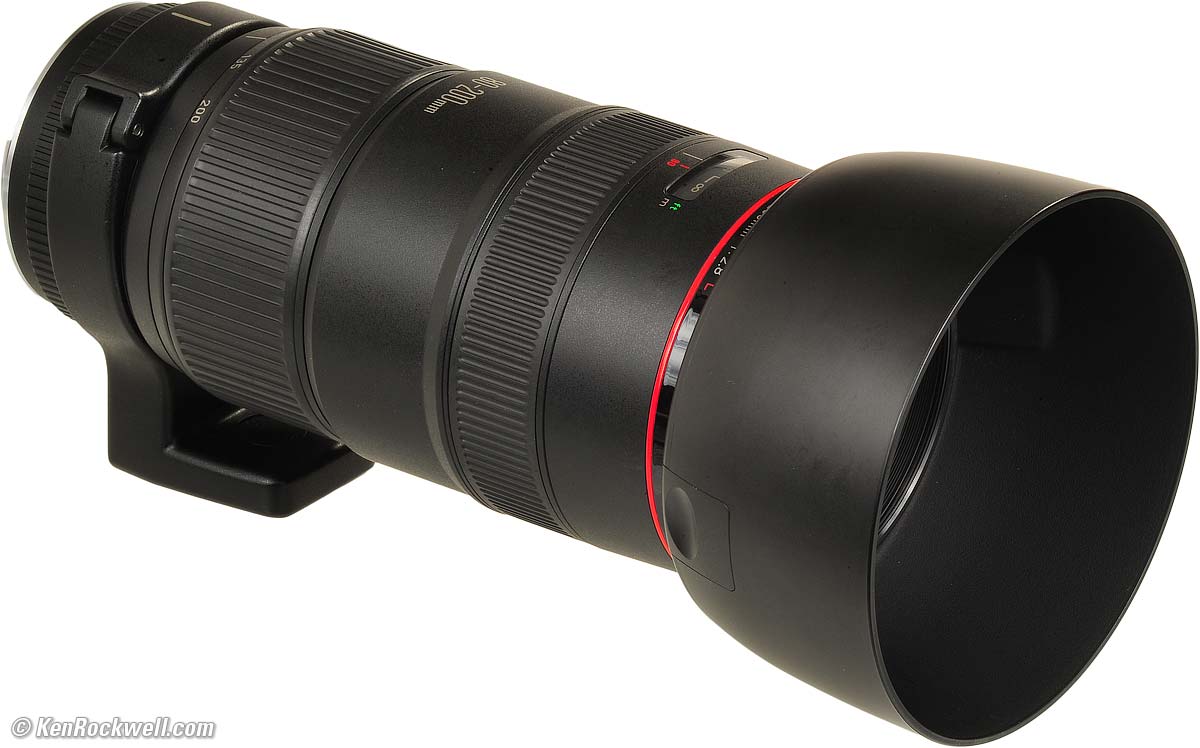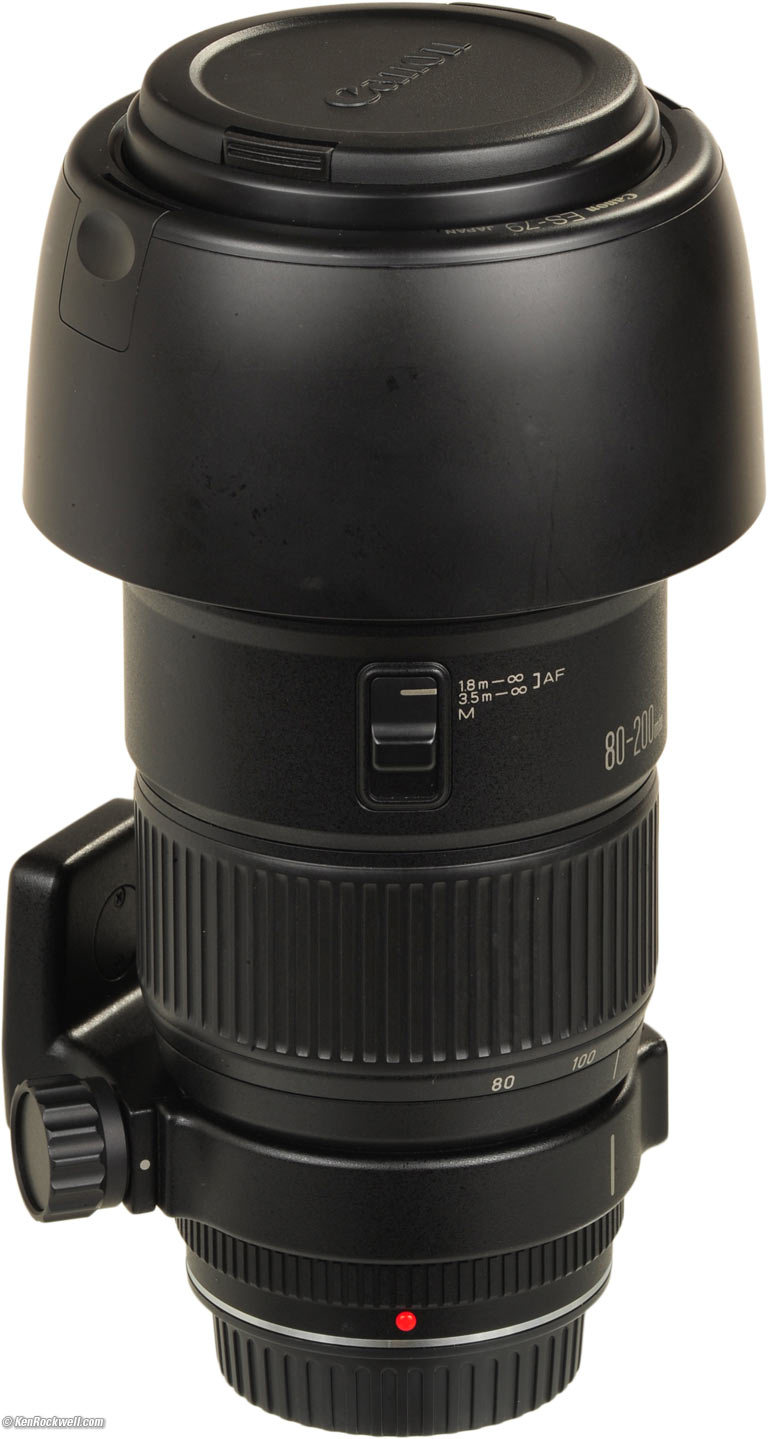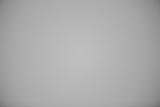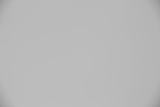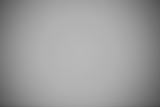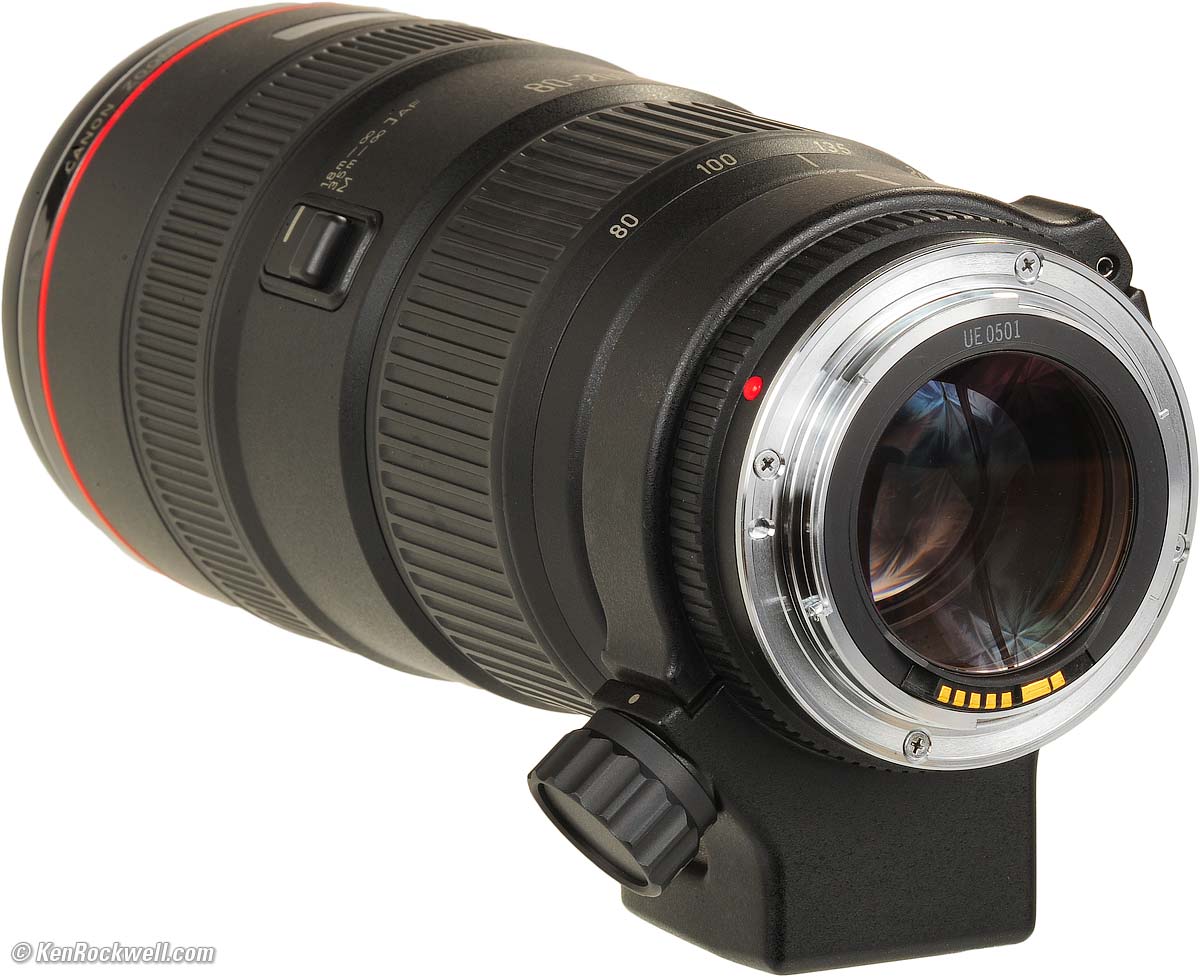Home Donate New Search Gallery Reviews How-To Books Links Workshops About Contact
Canon 80-200mm f/2.8 L
Full-Frame EF (1989-1995)
Intro Specs Performance Compared Usage Recommendations
Canon EF 80-200mm f/2.8 L (72mm filters, 5.9 feet/1.8m close-focus, 49.8 oz./1,412g with included tripod collar, 45.0 oz./1,276g without collar as shown, about $750 used.) enlarge. This free website's biggest source of support is when you use these links, especially this link directly to them at eBay (see How to Win at eBay) when you get anything, regardless of the country in which you live. It helps me keep reviewing these oldies when you get yours through these links, thanks! Ken.
September 2018 Canon Reviews Canon Lenses Canon Flash All Reviews
See also:
Sample Images from Olde Southern California March 2012.
Canon 70-200 Comparison Table.
Canon 70-200mm f/2.8L II (2010-today)
Canon 70-200mm f/2.8L IS (2001-2010)
Canon 70-200mm f/2.8L (1995-today)
Canon 70-200mm f/4L IS (2006-today)
Canon 70-200mm f/4L (1999-today)
Introduction top
Intro Specs Performance Compared Usage Recommendations
|
I buy only from these approved sources. I can't vouch for ads below. |
This Canon EF 80-200mm f/2.8 L is a fantastic telephoto zoom. It was the world's top telephoto zoom in its heyday, and today is still one of the world's best professional zooms.
Its optics are as good as Canon's latest L-series telephoto zooms, the only differences being the lack of instant manual-focus override and Image Stabilization. If you can live without these, this lens sells for a fraction the price of the newest zooms, and is built tougher, has a better tripod collar and easier-to-use hood, and has much faster and easier zooming than today's bulky $2,500 Canon 70-200mm f/2.8L. If you don't mind sliding a switch for manual focus and don't need IS, I just saved you a lot of money.
Unlike today's more plasticy 70-200mm L zooms, this 80-200 2.8 has an all-metal barrel. It's one tough cookie; there are no rubber bumpers or plastic barrel sections.
This Canon EF 80-200mm f/2.8 L is optically a bit better than today's Canon 70-200mm f/4L IS, but not quite as good as the beyond extraordinary Canon 70-200mm f/2.8L. All of these three lenses are among the best zooms ever made.
This Canon EF 80-200mm f/2.8 L was so good that it won the professional market away from Nikon in the early 1990!
Canon saw the future in autofocus, while Nikon thought pros didn't care, and offered mostly clunky AF products instead. Nikon's competitive lens at the time was the pokey push-pull Nikon 80-200/2.8 AF. Nikon didn't introduce an 80-200 lens that focused as fast as this 1989 Canon lens until the Nikon 80-200mm f/2.8 AF-D (new) of 1997, eight years later. By that time, that new Nikon lens still used sloppy mechanical autofocus, while Canon's 80-200/2.8 lens had been updated two years before in 1995 to the slick 70-200/2.8 USM that added instant manual-focus override, something Nikon wouldn't copy until 1999, four years after Canon! The 80-200 is the most important pro lens, and when Nikon couldn't keep up, Canon won.
This lens, along with the EF 20-35mm f/2.8 L, EF 300mm f/2.8 L and EF 50mm f/1.0 L, was the lens that won the pro market for Canon. Canon skipped no expense with the design of this 80-200/2.8 L; Canon was betting its future on the EOS system, and this was the most important lens in that system to the pros Canon was trying to convert.
Nikon has never gotten the majority of the pro market back because there has never been any strong reason to dump everything and change brands again. Canon won when everyone switched to autofocus, and this was the lens that was designed so well that it helped Canon win it.
Not only is the 80-200/2.8 L very sharp, it also has less distortion than any other 70-200mm zoom except the newest Canon 70-200mm f/2.8L II.
No wonder this lens was in every pro's bag in the early 1990s.
This Canon EF 80-200mm f/2.8L lens was replaced in 1995 by the lighter and more plasticy Canon 70-200mm f/2.8 L USM, which weighs a little less and focuses a little closer. The main difference is that the newer 70-200/2.8 USM lens offers instant manual-focus override, while one must move a switch on this 80-200 lens. The Canon 70-200mm f/2.8 L USM is still sold today, but look out: its tripod collar is a pain and its zoom ring moves much more slowly and needs much more force to move it.
Canon EF 80-200mm f/2.8 L(72mm filters, 5.9 feet/1.8m close-focus, 49.8 oz./1,412g with tripod collar, 45.0 oz./1,276g without collar, about $750 used.) enlarge.
Compatibility and Formats
This professional L lens is optimized for 35mm film and full-frame digital, and of course works on 1.3x and 1.6x Canon cameras.
This Canon EF EOS 80-200mm f/2.8L works perfectly with every Canon EOS camera ever made, meaning every Canon DSLR and every Canon autofocus 35mm camera made since 1987.
This means of course it works great on today's 5D Mark II and Canon 7D, but it works just as well on my original Canon EOS 620 from 1987!
As a full-frame lens, this works on all Canon SLRs, regardless of format. As a professional lens, I will be reviewing this lens on full-frame.
Specifications top
Intro Specs Performance Compared Usage Recommendations
Name
Canon calls this the CANON ZOOM LENS EF 80-200mm f/2.8 L.
EF means "electronic focus," meaning that there is an autofocus motor in the lens itself. All Canon lenses since 1987 have been EF.
L only means as expensive as L; it means nothing technically.
Optics top
16 elements in 13 groups.
Internal focus and internal zoom; nothing moves externally as focused or zoomed.
Diaphragm top
Front, Canon 80-200 L at 200mm and f/2.8 (EF diaphragm not visible). enlarge.
8 blades.
Stops down to f/32.
Circular at f/4, octagonal from f/8 to f/32.
Focal Length
80~200mm.
On 1.3x Canon cameras it will see angles-of-view similar to what a 105~260mm lens would see on a 35mm camera.
On 1.6x Canon cameras it will see angles-of-view similar to what a 125~320mm lens would see on a 35mm camera.
Angle of View (on 35mm and full-frame cameras)
30º ~ 12º diagonal.
Close Focus top
5.9 feet (1.8m), specified, from the image plane.
Maximum Reproduction Ratio top
1:7.7.
Hard Infinity Focus Stop? top
No.
You have to let the AF system focus for you at infinity.
Focus Scale top
Yes.
The ring turns from infinity to the closest focus distance in about 105.º
Depth-of-Field Scale top
No.
Infra-Red Focus Indices top
Yes, mark for the 80mm focal length.
The mark is probably for the 800 nm wavelength.
Filter Thread top
72mm.
Metal.
Does not move, ever.
Tripod Collar top
Included.
Removable.
Super-easy to use and remove.
It also works on the Canon 70-200mm f/4L IS and Canon 70-200mm f/4L IS II.
The collar mounting surface on the 80-200/2.8 meaures 65.50mm diameter by 18.25mm wide.
Size top
Canon specifies 3.3" (84mm) diameter by 7-5/16" (185.7mm) long.
It doesn't change size as zoomed.
Weight top
45.025 oz. (1,276.4g) without tripod collar, measured.
49.805 oz. (1,411.95g) with tripod collar, measured.
52.635 oz. (1,492.2g) with caps, hood and tripod collar,, measured.
Collar alone: 4.780 oz. (135.5g).
Hood alone: 1.695 oz. (48.05g).
Canon specifies 46.4 oz. (1,330g), curiously an average between the collared and uncollared weights.
Hood top
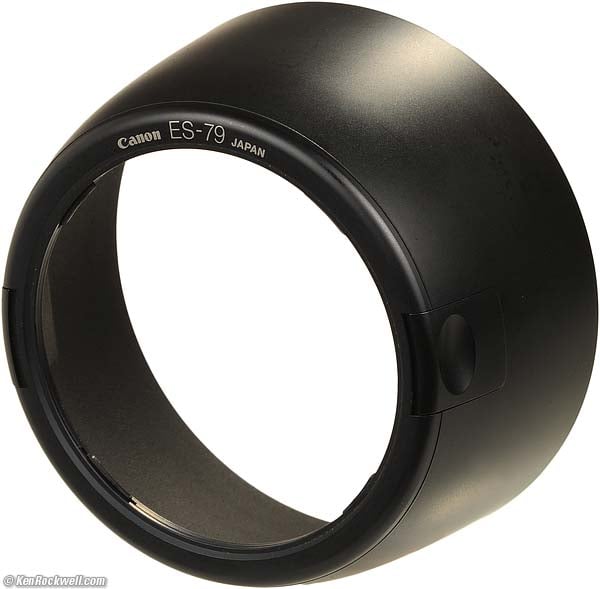
Included ES-79 hood.
$50 plastic bayonet ES-79, included.
Canon EF 80-200mm f/2.8 L with included ES-79 hood and tripod collar. enlarge.
I address how well they work at Ergonomics.
Case top
LH-D23 hard tubular case, included.
Caps top
Canon EF 80-200mm f/2.8 L with hood, caps and tripod collar. enlarge.
72mm E72 front, included. (non-ultrasonic cap with black-on-black Canon logo.)
Standard EOS cap rear.
Announced top
September 1989.
Quality top
Made in Japan.
Price, USA top
2011 December: about $750 used.
Performance top
Intro Specs Performance Compared Usage Recommendations
Overall Autofocus Bokeh Breathing Color Distortion
Ergonomics Falloff Filters Lateral Color Fringes
Mechanics Sharpness Spherochromatism Sunstars
Overall performance top
The Canon 80-200mm f/2.8 L is optically and mechanically superb.
It's also big and heavy.
Every sports pro had one of these in his bag in the early 1990s.
This is a 2011 test of a made-in-1990 lens, and it still looks and works like new.
Autofocus performance top
Autofocus is fast but not silent.
The Arc Form Drive (AFD) motor whines a little as it zips around.
Auto/Manual Switching
You must move the AF-MF switch to change modes.
AF Speed
AF is fast!, as Canons always are.
AF Accuracy and Consistency
Even at f/2.8, all my shots are dead-on at every focal length on my Canon 5D Mark II.
Yes!
Manual Focus
Manual focus is easy; just move the switch and turn the ring.
Bokeh performance top
Bokeh, the quality of out-of-focus areas as opposed to the degree of defocus, is very nice.
While not quite as smooth as the bokeh of the Canon 70-200mm f/2.8L II, backgrounds are never distracting, regardless of the zoom setting.
I describe the bokeh of this 80-200/2.8 L as organic. Background blobs are always soft, but not Gaussian, either.
Focus Breathing performance top
Focus breathing (the image changing size as focused) is mostly of interest to cinematographers who don't want the image changing size ("breathing") as the lens is focused among different subjects.
The image from the Canon 80-200mm f/2.8 L always gets larger as focused more closely.
Color Rendition performance top
The color balance of this 80-200mm f/2.8 L matches my other Canon EF lenses.
Distortion performance top
The Canon 80-200mm f/2.8 L has very little distortion. In fact, it's almost as low as the newest Canon 70-200mm f/2.8L II, which is the world's lowest-distortion tele zoom.
It has some barrel distortion at 80mm and some slight pincushion distortion at 200mm, but rarely anything you'll ever see except at 80mm.
For more critical use, use these values in Photoshop's Lens Distortion tool to remove it:
| on Full-Frame |
Infinity |
10' (3m) |
(For comparison: 70-200 II at 10'/3m) |
80mm |
+3.0 |
+2.0 |
(+1.5) |
100mm |
+1.0 |
+0.7 |
(0.0) |
135mm |
-0.5 |
-0.5 |
(-1.0) |
200mm |
-1.5 |
-1.5 |
(-1.5) |
© 2011 KenRockwell.com. All rights reserved.
Ergonomics performance top
This is an all-metal lens with better ergonomics than Canon's current tele zooms.
The zoom ring can be flicked with just a fingertip, much better than any other Canon f/2.8 tele zoom.
The tripod collar and hood attachment work much faster and easier than with current f/2.8 lenses.
The collar design is brilliant. It's easy to pop an assembled lens and camera system on and off using only your left hand.
The hood pops straight on with nothing to align, both in the regular and reversed positions. The only time one needs to press the buttons is to release the hood.
You've got to move a switch to get into manual focus, after which there is a bit of focus drag.
Falloff (darkened corners) performance top
Falloff is exactly the same as Canon's $2,500 Canon 70-200mm f/2.8L II!
Like most f/2.8 tele zooms, there is visible falloff wide-open at 200mm, and it goes away at shorter focal lengths or smaller apertures.
My Canon 5D Mark II (as of firmware 2.0.4) doesn't have the data to correct this automatically in its Peripheral Illumination Correction menu option. If you go find the data and load it into your camera (I'm too lazy), it should correct for this automatically.
I've greatly exaggerated this by shooting a flat gray target and presenting it against a gray background:
Canon 80-200mm f/2.8 falloff on Full-Frame No peripheral illumination correction
© 2011 KenRockwell.com. All rights reserved. |
Filters, Use with performance top
Filters are easy.
The sturdy and precise metal threads don't move, and there isn't any problem with vignetting. Feel free to use thick rotating filters. There is no need for expensive "thin" polarizers.
Lateral Color Fringes performance top
There are no lateral color fringes as seen on my Canon 5D Mark II at 135mm and 200mm.
At 100mm there is a almost no green/magenta color fringing.
At 80mm there is a very little bit of green/magenta color fringing.
Astoundingly, this is exactly the same as Canon's $2,500 Canon 70-200mm f/2.8L II!
Mechanics performance top
Rear, Canon 80-200 f/2.8 L. enlarge.
The Canon 80-200mm f/2.8 L is an all-alloy professional athlete. It's rock-hard and leaner than today's plumper offerings, but weighs more than you'd expect because it's all metal — not plastic.
Filter Threads
Metal.
Hood Mount
Metal.
Identity Ring
Metal.
Fore Barrel
Plastic.
Focus Ring
Metal, rubber-covered.
Mid-barrel
Metal.
AF Mode Switch
Plastic.
Internals
Metal.
Zoom Ring
Metal, rubber-covered.
Rear barrel
Metal.
Moisture seal at mount
No.
Mount
Chromed metal.
Markings
Paint.
Serial Number
Engraved into bottom of lens barrel and filled with white paint.
Date Code
Yes, printed into the rear light shield.
See Canon Date Codes to find your lens' birthday.
This sample is stamped UE0501, meaning May 1990.
Noises When Shaken
Moderate clunking.
Made in
Japan.
Sharpness performance top
As shot on the 5D Mark II under test conditions at infinity, this Canon 80-200mm f/2.8 L isn't quite as good as the extraordinary Canon 70-200mm f/2.8L II, but it is better than today's Canon 70-200mm f/4L IS, making this one heck of a sharp lens:
Oceanside Harbor, 4:17 PM 02 March 2012. Canon 5D Mk II, 80-200/2.8 at 115mm, f/9 at 1/1,000 at D+ ISO 200. full-resolution.
At 80mm, it's always sharp in the center. The corners can be a but softer, cleaning up by f/8.
At 100mm, the center is a bit less contrasty at f/2.8, and right up there by f/4. The sides are a little softer at f/2.8, and super-sharp by f/5.6.
At 135mm, the center is a bit less contrasty at f/2.8, and right up there by f/4. The sides are a little softer at f/2.8, and super-sharp by f/5.6.
At 200mm, it's always sharp in the center. The corners can be a but softer, cleaning up by f/8.
Diffraction starts to dull everything by f/11. f/8 is optimum.
Spherochromatism performance top
I see no spherochromatism
Spherochromatism, misnamed "color bokeh" by laymen, is when out-of-focus highlights take on color fringes. The Canon 80-200/2.8L's out-of-focus highlights have no color fringes.
Spherochromatism is a completely different aberration from lateral color fringes.
Sunstars performance top
With its 8-bladed diaphragm, this Canon 80-200mm f/2.8 L should make boring Canon-standard 8-pointed sunstars on brilliant points of light.
Compared top
Intro Specs Performance Compared Usage Recommendations
See my Canon 70-200 Comparison Table.
Usage top
Intro Specs Performance Compared Usage Recommendations
Focus Limiter and Mode Switch
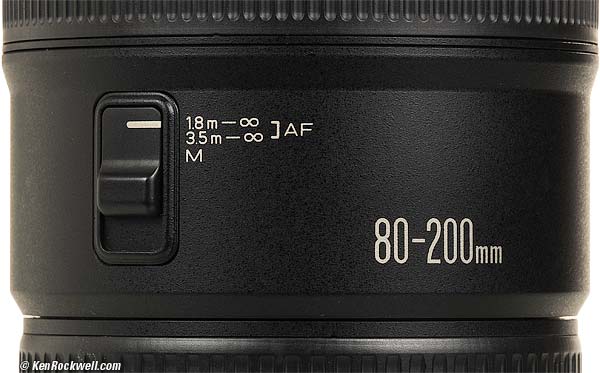
Focus limiter.
Leave it in the "1.8m ~ ∞ AF " position.
The "3.5m ~ ∞ AF " position prevents the lens from focusing any closer than 3.5 meters (11 feet). You might use this if you're shooting action at a distance and the lens is wasting time trying to focus this close and back looking for things.
The manual focus ring is ignored in either AF position.
The M position is manual focus.
Tripod Collar
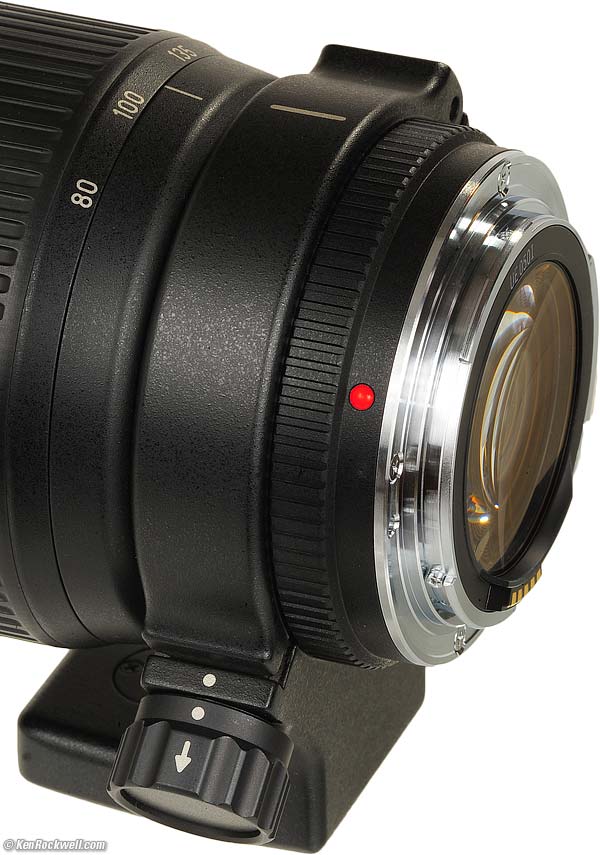
Included tripod collar.
This collar's release is brilliant: just rotate a quarter-turn and pull as shown to open. You can remove or attach the camera and lens combo all at once. To close, just push the top half back down to latch.
Once latched closed, just rotate the knob slightly to tighten and loosen.
Yes, you can have your rig on a tripod, and with one quick flick of your left hand, take the whole lens and camera system on and off in a flash. With the newest $2,500 Canon 70-200mm f/2.8L II, this same operation takes a few hands and several minutes of cursing to remove the body from the lens and then extract the lens out the back of the tripod mount, and then reattach the lens to the camera body.
This tripod collar is much better than on newer lenses that use a dopey screw system and also require you to take the lens off the camera to slide in and out. This collar uses an offset pin and latch, not a screw.
Better still, this lens needs no exposed screw heads on the lens barrel like the newer lenses. This 80-200/2.8 lens barrel is completely smooth so it's comfortable to hand-hold, while the new lenses have uncomfortable exposed screw heads on the barrel to latch with their goofy collars. What good is the IS of other lenses if you aren't going to want to hand-hold them because of uncomfortable screw heads poking out where the collar is supposed to be?
Even more better, this same brilliant collar also works on the Canon 70-200mm f/4L IS!
Hood

Included ES-79 hood.
The ES-79 hood is much easier and more pleasant to use than the bayonet monstrosities of newer lenses. The ES-79 just pops right on and locks automatically, forward or reversed, with no need ever to align anything.
The only time you need to press anything is to release it.
Recommendations top
Intro Specs Performance Compared Usage Recommendations
If you want unexcelled mechanical toughness and precision, top-flight ergonomics and superb optics, but prefer a bargain over paying for IS and instant manual-focus override, this is your lens.
Also look at the Canon EF 20-35mm f/2.8 L of the same era, which shares the same tough all-metal barrel and 72mm filter size.
Personally, as an outdoor nature and landscape shooter, I'm too lazy to want to haul this beast around the woods with me. I own the 70-200mm f/4 IS for when I want a zoom, and use the EF 100mm f/2 for when I can forgo a zoom and want fantastic optics in an even smaller package.
If you've found the time I've spent sharing this professional review helpful, this free website's biggest source of support is when you use these links, especially this link directly to them at eBay (see How to Win at eBay) when you get anything, regardless of the country in which you live. It helps me keep reviewing these oldies when you get yours through these links, thanks! Ken.
Thanks!
Ken.
© Ken Rockwell. All rights reserved. Tous droits réservés. Alle Rechte vorbehalten.
Help Me Help You
I support my growing family through this website, as crazy as it might seem.
The biggest help is when you use any of these links when you get anything. It costs you nothing, and is this site's, and thus my family's, biggest source of support. These places always have the best prices and service, which is why I've used them since before this website existed. I recommend them all personally.
If you find this page as helpful as a book you might have had to buy or a workshop you may have had to take, feel free to help me continue helping everyone.
If you've gotten your gear through one of my links or helped otherwise, you're family. It's great people like you who allow me to keep adding to this site full-time. Thanks!
If you haven't helped yet, please do, and consider helping me with a gift of $5.00.
As this page is copyrighted and formally registered, it is unlawful to make copies, especially in the form of printouts for personal use. If you wish to make a printout for personal use, you are granted one-time permission only if you PayPal me $5.00 per printout or part thereof. Thank you!
Thanks for reading!
Mr. & Mrs. Ken Rockwell, Ryan and Katie.







